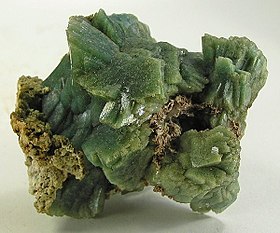This article needs additional citations for verification. (April 2013) |
| Heulandite | |
|---|---|
 | |
| General | |
| Category | Zeolites (tectosilicates) |
| Formula (repeating unit) | (Ca,Na)2−3Al3(Al,Si)2Si13O36·12H2O |
| IMA symbol | Hul[1] |
| Strunz classification | 9.GE.05 |
| Crystal system | Monoclinic More than one space group |
| Crystal class | Prismatic (2/m) (same H-M symbol) |
| Identification | |
| Colour | colourless, yellow, green, white, pale pink |
| Crystal habit | tabular, parallel aggregates |
| Cleavage | perfect basal |
| Mohs scale hardness | 3.5–4 |
| Lustre | pearly, vitreous |
| Streak | white |
| Diaphaneity | transparent to translucent |
| References | [2][3][4][5] |
Heulandite is the name of a series of tecto-silicate minerals of the zeolite group. Prior to 1997, heulandite was recognized as a mineral species, but a reclassification in 1997 by the International Mineralogical Association changed it to a series name, with the mineral species being named:
- Heulandite-Ca
- Heulandite-Na
- Heulandite-K
- Heulandite-Sr
- Heulandite-Ba (described in 2002).
Heulandite-Ca, the most common of these, is a hydrous calcium and aluminium silicate, (Ca,Na)2−3Al3(Al,Si)2Si13O36·12H2O. Small amounts of sodium and potassium are usually present replacing part of the calcium. Strontium replaces calcium in the heulandite-Sr variety. The appropriate species name depends on the dominant element. The species are visually indistinguishable, and the series name heulandite is still used whenever testing has not been performed.
- ^ Warr, L.N. (2021). "IMA–CNMNC approved mineral symbols". Mineralogical Magazine. 85 (3): 291–320. Bibcode:2021MinM...85..291W. doi:10.1180/mgm.2021.43. S2CID 235729616.
- ^ Mindat - Heulandite-Ca
- ^ Webmineral - Heulandite-Ca
- ^ Mineralienatlas
- ^ Simon and Schuster's Guide to Rocks and Minerals